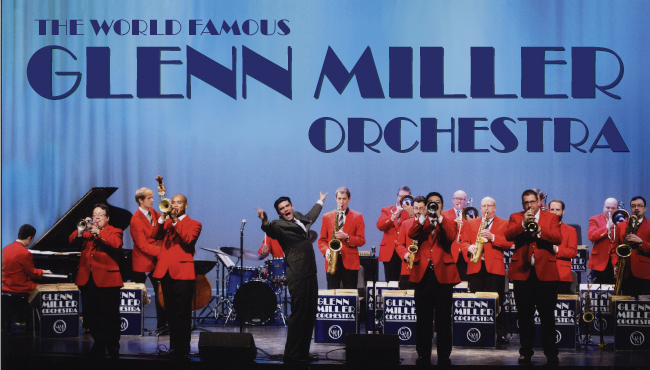The legendary Glenn Miller, who was one of the most  successful bandleaders back in the Swing Era and his influence led to the formation of the Glenn Miller Orchestra which will grace the SKyPAC stage on Friday, August 7 at 7:30 p.m. The present Glenn Miller Orchestra was formed in 1956 and has been touring consistently since, playing an average of 300 live dates a year all around the world. With their unique jazz sound, this group is one you won’t want to miss.
successful bandleaders back in the Swing Era and his influence led to the formation of the Glenn Miller Orchestra which will grace the SKyPAC stage on Friday, August 7 at 7:30 p.m. The present Glenn Miller Orchestra was formed in 1956 and has been touring consistently since, playing an average of 300 live dates a year all around the world. With their unique jazz sound, this group is one you won’t want to miss.
Tickets now on sale! Click here to buy now!
Presented by Bank of Edmonson
The Glenn Miller Orchestra is owned and operated by Glenn Miller Productions, Inc., under license from the Miller Estate. Glenn Miller Productions, Inc., has the sole and exclusive right to use the Glenn Miller Orchestra name.
The Glenn Miller Orchestra is a fully self-contained group consisting of the musical director, five saxophone players, four trumpeters, four trombonists, and three rhythm musicians (piano, bass and drums). Also, there are two vocalists, one male and one female, who perform individually and as part of The Moonlight Serenaders vocal group.
The big-band business today requires almost constant travel as a result of an arduous schedule of one-night stands. The Glenn Miller Orchestra is “on the road” longer and more continuously than any other in the whole world, having celebrated its 55th year anniversary on June 6, 2011. It covers over a hundred thousand miles a year, working most every night for 48 weeks out of every 52-nearly 300 playing dates, performing for an “in person” audience that adds up to more than a half million people annually.
The orchestra has performed in all 50 United States, as well as throughout Europe, Australia, Iceland, New Zealand, Guam, the Philippines, South and Central America. The orchestra’s tour of Japan during November/December 2011 will be its 44th annual tour of that country.
The “Road Book” carried by the Glenn Miller Orchestra adds up to over 300 charts-many of them out of the original library. Today, the complete library totals over 1,700 compositions including all of the original charts from both the civilian band and the Army Air Force Band.
Of course, all of the biggest hits are included in a regular program. But so are arrangements of less well-known tunes like The White Cliffs of Dover, Rainbow Rhapsody, Everybody Loves My Baby, and That’s Sabotage. The Miller library features contributions from many fine arrangers including Bill Finegan, Jerry Gray, Billy May, Mort Lindsay, Deane Kinkaide, Joe Cribari, and Dave Wolpe. They have added such numbers as Over the Rainbow, September Morn, The Body Electric from the T.V. series Fame, Up Where We Belong, from the hit movie, An Officer and a Gentleman, and Star Wars/War of The Stars.
The Glenn Miller Orchestra has always been very musical, disciplined, and visually entertaining. And it has its own distinctive “sound.”
That sound is created by the clarinet holding the melodic line, doubled or coupled with the tenor sax playing the same notes; and the harmonies produced by three other saxophones, while growling trombones and wailing trumpets add their oo-ahs.
Glenn Miller and His Orchestra made a big impact right before and during the war. And it had more hit records in one year than anybody in the history of the recording industry. In fact, its recording of Chattanooga Choo-Choo earned the first Gold Record ever awarded to a performing artist. Additional Gold Record recordings include “In the Digital Mood” and “In The Christmas Mood,” Volume I & II.
Back in the days of the big band era of the forties, any dance band “worth its salt” had a distinctive theme song. It was the musical signature with which they signed on and signed off at their engagements and radio broadcasts. The theme of Glenn Miller and His Orchestra was the beautiful Moonlight Serenade, and it is still the signature tune of the Glenn Miller Orchestra today. Interestingly enough, Glenn Miller originally wrote the music of the song himself as an exercise for a course in arranging. He composed it long before he organized his band, when he was a trombonist and arranger with Ray Noble’s famous band.
Today, it is considered a standard in the field of popular music with its popularity as an instrumental continuing undiminished through the years.
It is now more than 70 years since Glenn Miller first succeeded with the Orchestra, which still bears his name until this day. Except for a few years following his disappearance, Glenn’s orchestra and music have been heard around the world continuously since 1938.

